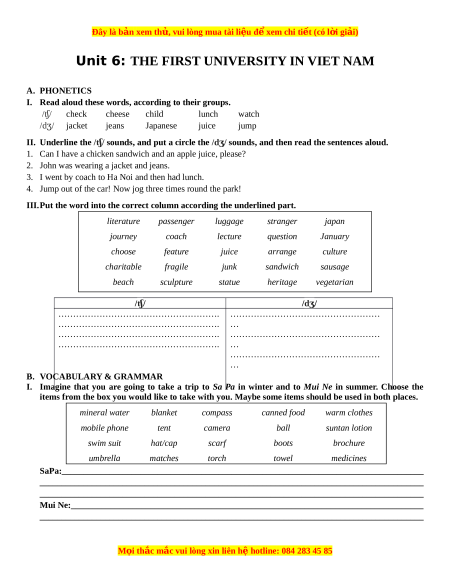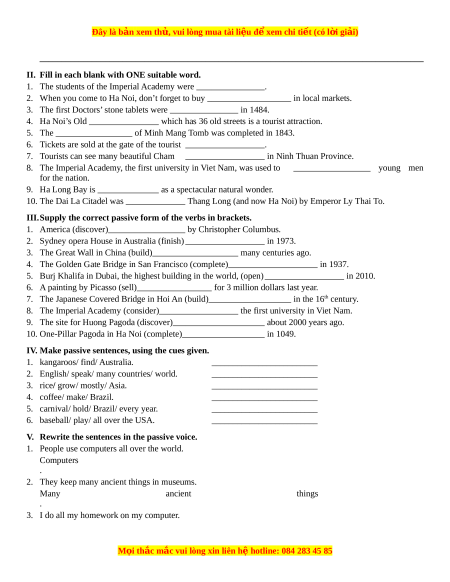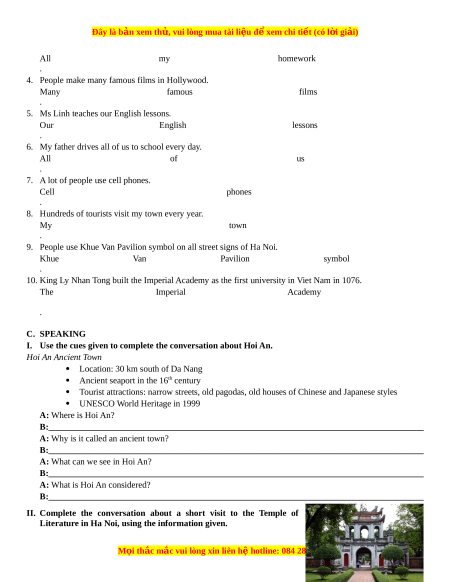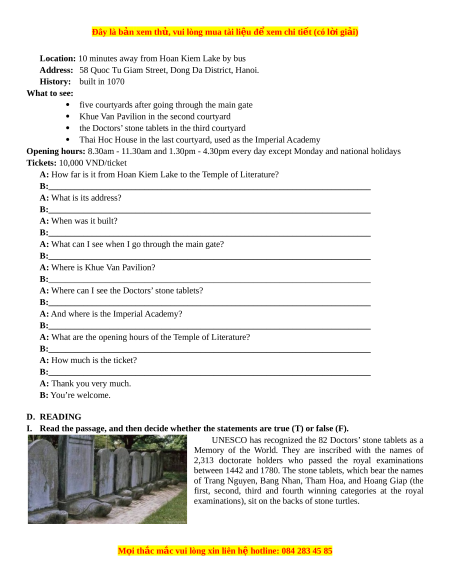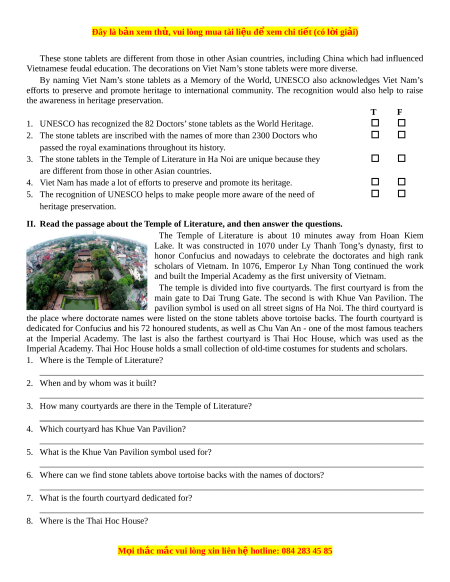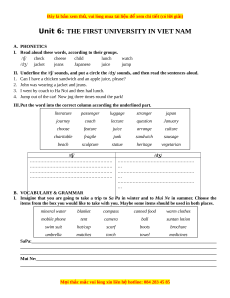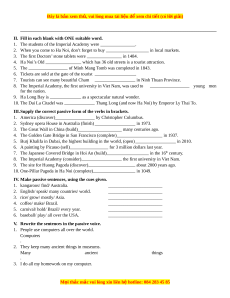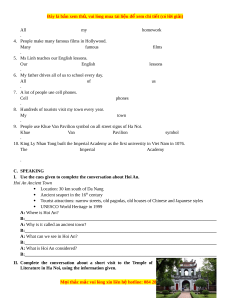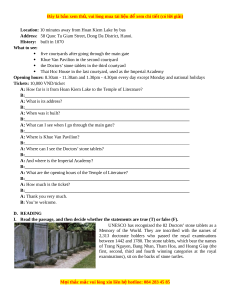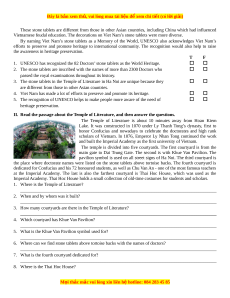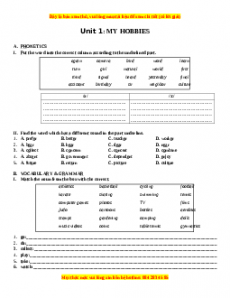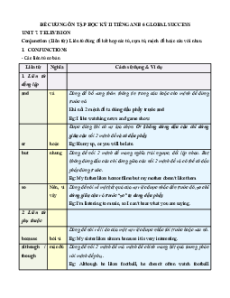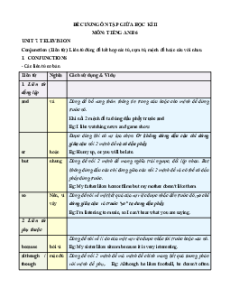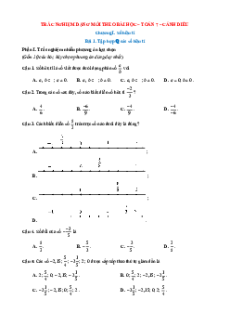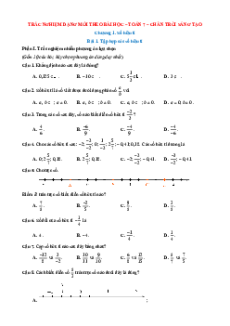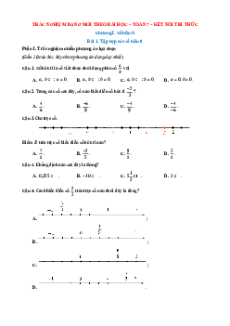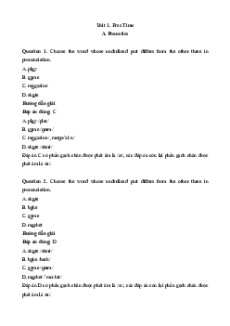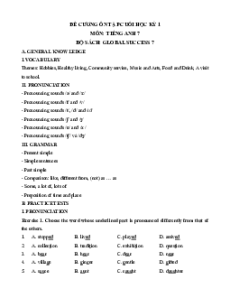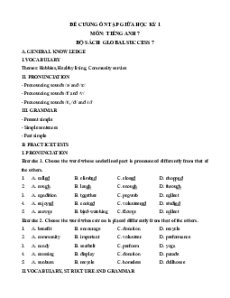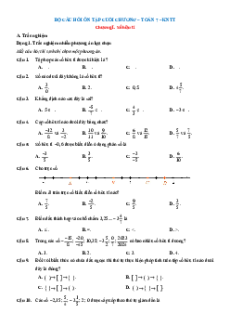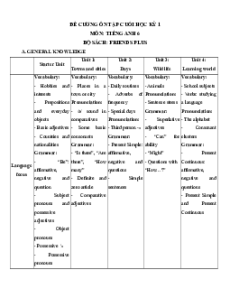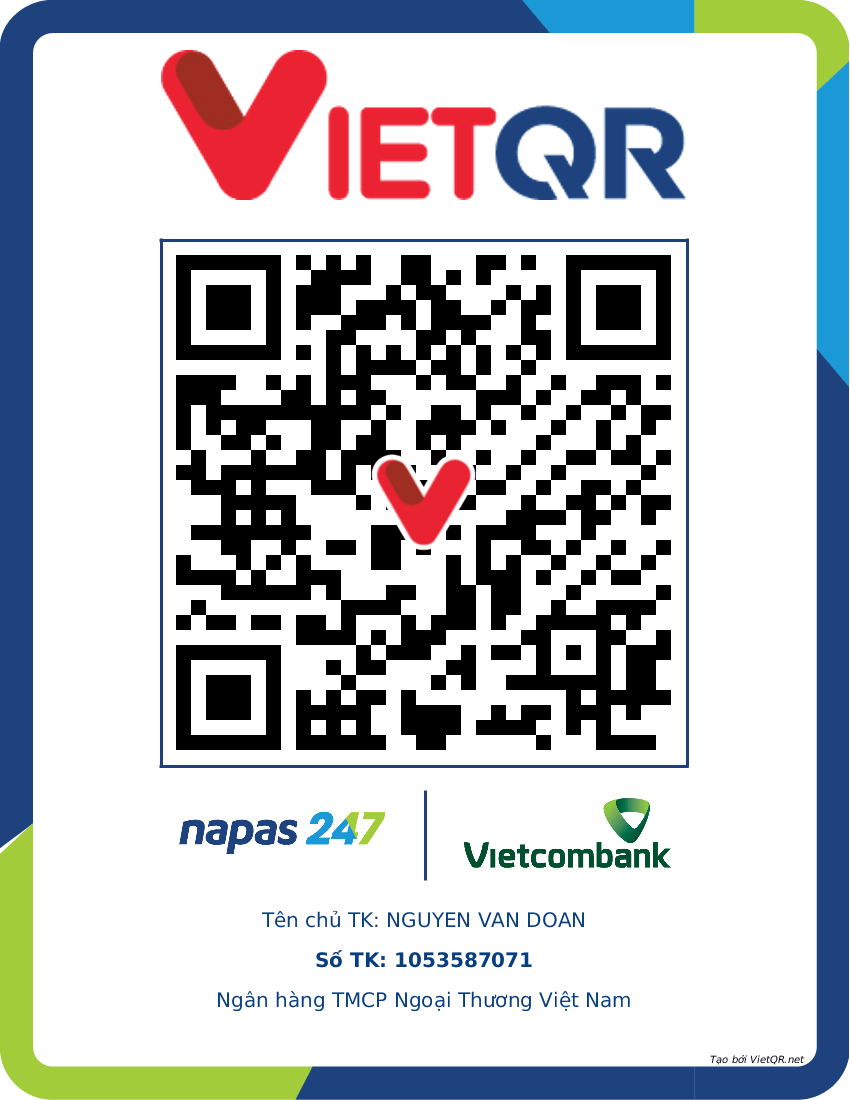ệ đ xe ể m chi ti t ế (có l i ờ gi i ả )
Unit 6: THE FIRST UNIVERSITY IN VIET NAM A. PHONETICS
I. Read aloud these words, according to their groups. /tʃ/ check cheese child lunch watch /dʒ/ jacket jeans Japanese juice jump
II. Underline the /tʃ/ sounds, and put a circle the /dʒ/ sounds, and then read the sentences aloud.
1. Can I have a chicken sandwich and an apple juice, please?
2. John was wearing a jacket and jeans.
3. I went by coach to Ha Noi and then had lunch.
4. Jump out of the car! Now jog three times round the park!
III.Put the word into the correct column according the underlined part. literature passenger luggage stranger japan journey coach lecture question January choose feature juice arrange culture charitable fragile junk sandwich sausage beach sculpture statue heritage vegetarian /tʃ/ /dʒ/
……………………………………………….
……………………………………………
………………………………………………. …
……………………………………………….
……………………………………………
………………………………………………. …
…………………………………………… … B. VOCABULARY & GRAMMAR
I. Imagine that you are going to take a trip to Sa Pa in winter and to Mui Ne in summer. Choose the
items from the box you would like to take with you. Maybe some items should be used in both places. mineral water blanket compass canned food warm clothes mobile phone tent camera ball suntan lotion swim suit hat/cap scarf boots brochure umbrella matches torch towel medicines
SaPa:___________________________________________________________________________________
________________________________________________________________________________________
________________________________________________________________________________________
Mui Ne:________________________________________________________________________________
________________________________________________________________________________________ M i
ọ thắc mắc vui lòng xin liên hệ hotline: 084 283 45 85
ệ đ xe ể m chi ti t ế (có l i ờ gi i ả )
________________________________________________________________________________________
II. Fill in each blank with ONE suitable word.
1. The students of the Imperial Academy were .
2. When you come to Ha Noi, don’t forget to buy in local markets.
3. The first Doctors’ stone tablets were in 1484. 4. Ha Noi’s Old
which has 36 old streets is a tourist attraction. 5. The
of Minh Mang Tomb was completed in 1843.
6. Tickets are sold at the gate of the tourist .
7. Tourists can see many beautiful Cham in Ninh Thuan Province.
8. The Imperial Academy, the first university in Viet Nam, was used to young men for the nation. 9. Ha Long Bay is
as a spectacular natural wonder. 10. The Dai La Citadel was
Thang Long (and now Ha Noi) by Emperor Ly Thai To.
III.Supply the correct passive form of the verbs in brackets. 1. America (discover) by Christopher Columbus.
2. Sydney opera House in Australia (finish) in 1973.
3. The Great Wall in China (build) many centuries ago.
4. The Golden Gate Bridge in San Francisco (complete) in 1937.
5. Burj Khalifa in Dubai, the highest building in the world, (open) in 2010.
6. A painting by Picasso (sell)
for 3 million dollars last year.
7. The Japanese Covered Bridge in Hoi An (build) in the 16th century.
8. The Imperial Academy (consider)
the first university in Viet Nam.
9. The site for Huong Pagoda (discover) about 2000 years ago.
10. One-Pillar Pagoda in Ha Noi (complete) in 1049.
IV. Make passive sentences, using the cues given.
1. kangaroos/ find/ Australia. _________________________
2. English/ speak/ many countries/ world. _________________________
3. rice/ grow/ mostly/ Asia. _________________________ 4. coffee/ make/ Brazil. _________________________
5. carnival/ hold/ Brazil/ every year. _________________________
6. baseball/ play/ all over the USA. _________________________
V. Rewrite the sentences in the passive voice.
1. People use computers all over the world. Computers .
2. They keep many ancient things in museums. Many ancient things .
3. I do all my homework on my computer. M i
ọ thắc mắc vui lòng xin liên hệ hotline: 084 283 45 85
ệ đ xe ể m chi ti t ế (có l i ờ gi i ả ) All my homework .
4. People make many famous films in Hollywood. Many famous films .
5. Ms Linh teaches our English lessons. Our English lessons .
6. My father drives all of us to school every day. All of us .
7. A lot of people use cell phones. Cell phones .
8. Hundreds of tourists visit my town every year. My town .
9. People use Khue Van Pavilion symbol on all street signs of Ha Noi. Khue Van Pavilion symbol .
10. King Ly Nhan Tong built the Imperial Academy as the first university in Viet Nam in 1076. The Imperial Academy . C. SPEAKING
I. Use the cues given to complete the conversation about Hoi An. Hoi An Ancient Town
Location: 30 km south of Da Nang
Ancient seaport in the 16th century
Tourist attractions: narrow streets, old pagodas, old houses of Chinese and Japanese styles UNESCO World Heritage in 1999 A: Where is Hoi An?
B:______________________________________________________________________________________
A: Why is it called an ancient town?
B:______________________________________________________________________________________
A: What can we see in Hoi An?
B:______________________________________________________________________________________
A: What is Hoi An considered?
B:______________________________________________________________________________________
II. Complete the conversation about a short visit to the Temple of
Literature in Ha Noi, using the information given. M i
ọ thắc mắc vui lòng xin liên hệ hotline: 084 283 45 85
ệ đ xe ể m chi ti t ế (có l i ờ gi i ả )
Location: 10 minutes away from Hoan Kiem Lake by bus
Address: 58 Quoc Tu Giam Street, Dong Da District, Hanoi. History: built in 1070 What to see:
five courtyards after going through the main gate
Khue Van Pavilion in the second courtyard
the Doctors’ stone tablets in the third courtyard
Thai Hoc House in the last courtyard, used as the Imperial Academy
Opening hours: 8.30am - 11.30am and 1.30pm - 4.30pm every day except Monday and national holidays
Tickets: 10,000 VND/ticket
A: How far is it from Hoan Kiem Lake to the Temple of Literature?
B:__________________________________________________________________________ A: What is its address?
B:__________________________________________________________________________ A: When was it built?
B:__________________________________________________________________________
A: What can I see when I go through the main gate?
B:__________________________________________________________________________
A: Where is Khue Van Pavilion?
B:__________________________________________________________________________
A: Where can I see the Doctors’ stone tablets?
B:__________________________________________________________________________
A: And where is the Imperial Academy?
B:__________________________________________________________________________
A: What are the opening hours of the Temple of Literature?
B:__________________________________________________________________________ A: How much is the ticket?
B:__________________________________________________________________________ A: Thank you very much. B: You’re welcome. D. READING
I. Read the passage, and then decide whether the statements are true (T) or false (F).
UNESCO has recognized the 82 Doctors’ stone tablets as a
Memory of the World. They are inscribed with the names of
2,313 doctorate holders who passed the royal examinations
between 1442 and 1780. The stone tablets, which bear the names
of Trang Nguyen, Bang Nhan, Tham Hoa, and Hoang Giap (the
first, second, third and fourth winning categories at the royal
examinations), sit on the backs of stone turtles. M i
ọ thắc mắc vui lòng xin liên hệ hotline: 084 283 45 85
Bài tập Unit 6: The first university in Viet Nam Tiếng Anh 7 chương trình thí điểm - Lưu Hoằng Trí
409
205 lượt tải
MUA NGAY ĐỂ XEM TOÀN BỘ TÀI LIỆU
CÁCH MUA:
- B1: Gửi phí vào TK:
1133836868- CT TNHH DAU TU VA DV GD VIETJACK - Ngân hàng MB (QR) - B2: Nhắn tin tới Zalo VietJack Official ( nhấn vào đây ) để xác nhận thanh toán và tải tài liệu - giáo án
Liên hệ ngay Hotline hỗ trợ: 084 283 45 85
Tài liệu được cập nhật liên tục trong gói này từ nay đến hết tháng 6/2023. Chúng tôi đảm bảo đủ số lượng đề đã cam kết hoặc có thể nhiều hơn, tất cả có BẢN WORD, LỜI GIẢI CHI TIẾT và tải về dễ dàng.
Để tải tài liệu gốc về máy bạn click vào nút Tải Xuống ở trên!
Thuộc bộ (mua theo bộ để tiết kiệm hơn):
- Tailieugiaovien.com.vn giới thiệu Bộ bài tập trắc nghiệm Tiếng Anh lớp 7 theo chương trình thí điểm biên soạn bởi GV Lưu Hoằng Trí mới nhất nhằm giúp Giáo viên có thêm tài liệu tham khảo bài tập Tiếng Anh lớp 7.
- File word có lời giải chi tiết 100%.
- Mua trọn bộ sẽ tiết kiệm hơn tải lẻ 50%.
Đánh giá
4.6 / 5(409 )5
4
3
2
1
Trọng Bình
Tài liệu hay
Giúp ích cho tôi rất nhiều
Duy Trần
Tài liệu chuẩn
Rất thích tài liệu bên VJ soạn (bám sát chương trình dạy)
TÀI LIỆU BỘ BÁN CHẠY MÔN Tiếng Anh
Xem thêmTÀI LIỆU BỘ BÁN CHẠY Lớp 7
Xem thêmTài liệu bộ mới nhất

Đây là b nả xem thử, vui lòng mua tài li u đ xem chi ti t (có l i gi i)ệ ể ế ờ ả
Unit 6: THE FIRST UNIVERSITY IN VIET NAM
A. PHONETICS
I. Read aloud these words, according to their groups.
/t /ʃ check cheese child lunch watch
/dʒ/ jacket jeans Japanese juice jump
II. Underline the /t / ʃ sounds, and put a circle the /dʒ/ sounds, and then read the sentences aloud.
1. Can I have a chicken sandwich and an apple juice, please?
2. John was wearing a jacket and jeans.
3. I went by coach to Ha Noi and then had lunch.
4. Jump out of the car! Now jog three times round the park!
III.Put the word into the correct column according the underlined part.
B. VOCABULARY & GRAMMAR
I. Imagine that you are going to take a trip to Sa Pa in winter and to Mui Ne in summer. Choose the
items from the box you would like to take with you. Maybe some items should be used in both places.
SaPa:___________________________________________________________________________________
________________________________________________________________________________________
________________________________________________________________________________________
Mui Ne:________________________________________________________________________________
________________________________________________________________________________________
M iọ th c m c vui lòng xin liên hắ ắ ệ hotline: 084 283 45 85
literature passenger luggage stranger japan
journey coach lecture question January
choose feature juice arrange culture
charitable fragile junk sandwich sausage
beach sculpture statue heritage vegetarian
/tʃ/ /dʒ/
……………………………………………….
……………………………………………….
……………………………………………….
……………………………………………….
……………………………………………
…
……………………………………………
…
……………………………………………
…
mineral water blanket compass canned food warm clothes
mobile phone tent camera ball suntan lotion
swim suit hat/cap scarf boots brochure
umbrella matches torch towel medicines

Đây là b nả xem thử, vui lòng mua tài li u đ xem chi ti t (có l i gi i)ệ ể ế ờ ả
________________________________________________________________________________________
II. Fill in each blank with ONE suitable word.
1. The students of the Imperial Academy were .
2. When you come to Ha Noi, don’t forget to buy in local markets.
3. The first Doctors’ stone tablets were in 1484.
4. Ha Noi’s Old which has 36 old streets is a tourist attraction.
5. The of Minh Mang Tomb was completed in 1843.
6. Tickets are sold at the gate of the tourist .
7. Tourists can see many beautiful Cham in Ninh Thuan Province.
8. The Imperial Academy, the first university in Viet Nam, was used to young men
for the nation.
9. Ha Long Bay is as a spectacular natural wonder.
10. The Dai La Citadel was Thang Long (and now Ha Noi) by Emperor Ly Thai To.
III.Supply the correct passive form of the verbs in brackets.
1. America (discover) by Christopher Columbus.
2. Sydney opera House in Australia (finish) in 1973.
3. The Great Wall in China (build) many centuries ago.
4. The Golden Gate Bridge in San Francisco (complete) in 1937.
5. Burj Khalifa in Dubai, the highest building in the world, (open) in 2010.
6. A painting by Picasso (sell) for 3 million dollars last year.
7. The Japanese Covered Bridge in Hoi An (build) in the 16
th
century.
8. The Imperial Academy (consider) the first university in Viet Nam.
9. The site for Huong Pagoda (discover) about 2000 years ago.
10. One-Pillar Pagoda in Ha Noi (complete) in 1049.
IV. Make passive sentences, using the cues given.
1. kangaroos/ find/ Australia. _________________________
2. English/ speak/ many countries/ world. _________________________
3. rice/ grow/ mostly/ Asia. _________________________
4. coffee/ make/ Brazil. _________________________
5. carnival/ hold/ Brazil/ every year. _________________________
6. baseball/ play/ all over the USA. _________________________
V. Rewrite the sentences in the passive voice.
1. People use computers all over the world.
Computers
.
2. They keep many ancient things in museums.
Many ancient things
.
3. I do all my homework on my computer.
M iọ th c m c vui lòng xin liên hắ ắ ệ hotline: 084 283 45 85

Đây là b nả xem thử, vui lòng mua tài li u đ xem chi ti t (có l i gi i)ệ ể ế ờ ả
All my homework
.
4. People make many famous films in Hollywood.
Many famous films
.
5. Ms Linh teaches our English lessons.
Our English lessons
.
6. My father drives all of us to school every day.
All of us
.
7. A lot of people use cell phones.
Cell phones
.
8. Hundreds of tourists visit my town every year.
My town
.
9. People use Khue Van Pavilion symbol on all street signs of Ha Noi.
Khue Van Pavilion symbol
.
10. King Ly Nhan Tong built the Imperial Academy as the first university in Viet Nam in 1076.
The Imperial Academy
.
C. SPEAKING
I. Use the cues given to complete the conversation about Hoi An.
Hoi An Ancient Town
Location: 30 km south of Da Nang
Ancient seaport in the 16
th
century
Tourist attractions: narrow streets, old pagodas, old houses of Chinese and Japanese styles
UNESCO World Heritage in 1999
A: Where is Hoi An?
B:______________________________________________________________________________________
A: Why is it called an ancient town?
B:______________________________________________________________________________________
A: What can we see in Hoi An?
B:______________________________________________________________________________________
A: What is Hoi An considered?
B:______________________________________________________________________________________
II. Complete the conversation about a short visit to the Temple of
Literature in Ha Noi, using the information given.
M iọ th c m c vui lòng xin liên hắ ắ ệ hotline: 084 283 45 85

Đây là b nả xem thử, vui lòng mua tài li u đ xem chi ti t (có l i gi i)ệ ể ế ờ ả
Location: 10 minutes away from Hoan Kiem Lake by bus
Address: 58 Quoc Tu Giam Street, Dong Da District, Hanoi.
History: built in 1070
What to see:
five courtyards after going through the main gate
Khue Van Pavilion in the second courtyard
the Doctors’ stone tablets in the third courtyard
Thai Hoc House in the last courtyard, used as the Imperial Academy
Opening hours: 8.30am - 11.30am and 1.30pm - 4.30pm every day except Monday and national holidays
Tickets: 10,000 VND/ticket
A: How far is it from Hoan Kiem Lake to the Temple of Literature?
B:__________________________________________________________________________
A: What is its address?
B:__________________________________________________________________________
A: When was it built?
B:__________________________________________________________________________
A: What can I see when I go through the main gate?
B:__________________________________________________________________________
A: Where is Khue Van Pavilion?
B:__________________________________________________________________________
A: Where can I see the Doctors’ stone tablets?
B:__________________________________________________________________________
A: And where is the Imperial Academy?
B:__________________________________________________________________________
A: What are the opening hours of the Temple of Literature?
B:__________________________________________________________________________
A: How much is the ticket?
B:__________________________________________________________________________
A: Thank you very much.
B: You’re welcome.
D. READING
I. Read the passage, and then decide whether the statements are true (T) or false (F).
UNESCO has recognized the 82 Doctors’ stone tablets as a
Memory of the World. They are inscribed with the names of
2,313 doctorate holders who passed the royal examinations
between 1442 and 1780. The stone tablets, which bear the names
of Trang Nguyen, Bang Nhan, Tham Hoa, and Hoang Giap (the
first, second, third and fourth winning categories at the royal
examinations), sit on the backs of stone turtles.
M iọ th c m c vui lòng xin liên hắ ắ ệ hotline: 084 283 45 85

Đây là b nả xem thử, vui lòng mua tài li u đ xem chi ti t (có l i gi i)ệ ể ế ờ ả
These stone tablets are different from those in other Asian countries, including China which had influenced
Vietnamese feudal education. The decorations on Viet Nam’s stone tablets were more diverse.
By naming Viet Nam’s stone tablets as a Memory of the World, UNESCO also acknowledges Viet Nam’s
efforts to preserve and promote heritage to international community. The recognition would also help to raise
the awareness in heritage preservation.
T F
1. UNESCO has recognized the 82 Doctors’ stone tablets as the World Heritage.
2. The stone tablets are inscribed with the names of more than 2300 Doctors who
passed the royal examinations throughout its history.
3. The stone tablets in the Temple of Literature in Ha Noi are unique because they
are different from those in other Asian countries.
4. Viet Nam has made a lot of efforts to preserve and promote its heritage.
5. The recognition of UNESCO helps to make people more aware of the need of
heritage preservation.
II. Read the passage about the Temple of Literature, and then answer the questions.
The Temple of Literature is about 10 minutes away from Hoan Kiem
Lake. It was constructed in 1070 under Ly Thanh Tong’s dynasty, first to
honor Confucius and nowadays to celebrate the doctorates and high rank
scholars of Vietnam. In 1076, Emperor Ly Nhan Tong continued the work
and built the Imperial Academy as the first university of Vietnam.
The temple is divided into five courtyards. The first courtyard is from the
main gate to Dai Trung Gate. The second is with Khue Van Pavilion. The
pavilion symbol is used on all street signs of Ha Noi. The third courtyard is
the place where doctorate names were listed on the stone tablets above tortoise backs. The fourth courtyard is
dedicated for Confucius and his 72 honoured students, as well as Chu Van An - one of the most famous teachers
at the Imperial Academy. The last is also the farthest courtyard is Thai Hoc House, which was used as the
Imperial Academy. Thai Hoc House holds a small collection of old-time costumes for students and scholars.
1. Where is the Temple of Literature?
________________________________________________________________________________________
2. When and by whom was it built?
________________________________________________________________________________________
3. How many courtyards are there in the Temple of Literature?
________________________________________________________________________________________
4. Which courtyard has Khue Van Pavilion?
________________________________________________________________________________________
5. What is the Khue Van Pavilion symbol used for?
________________________________________________________________________________________
6. Where can we find stone tablets above tortoise backs with the names of doctors?
________________________________________________________________________________________
7. What is the fourth courtyard dedicated for?
________________________________________________________________________________________
8. Where is the Thai Hoc House?
M iọ th c m c vui lòng xin liên hắ ắ ệ hotline: 084 283 45 85
